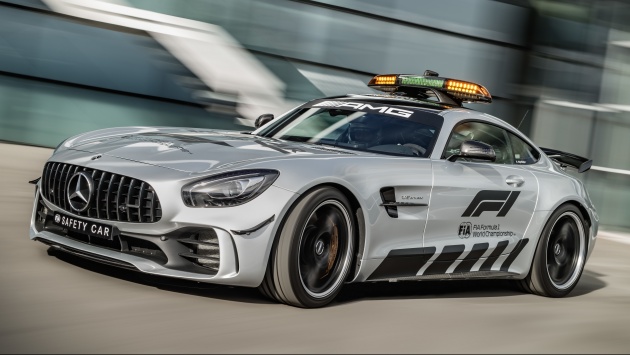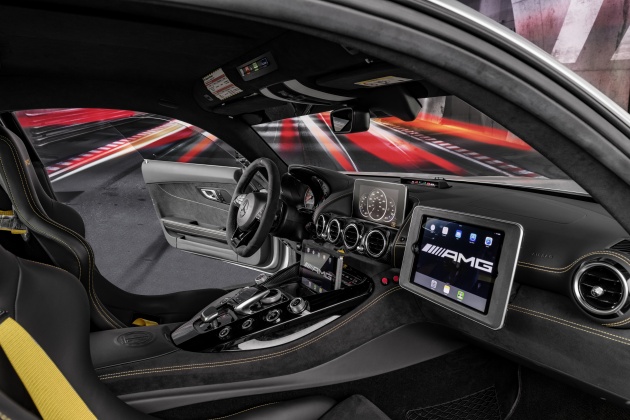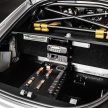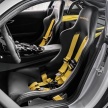The first race of the 2018 Formula 1 season in Melbourne is just days away, and along with a new logo, new regulations, a new halo device and new Pirelli tyre compounds, there will also be a new safety car making the rounds at each race. This time, it’s the monstrous Mercedes-AMG GT R, which takes over from the more tepid GT S that has served since 2015.
With 585 hp and a thumping 700 Nm coming from the front-mid-mounted 4.0 litre biturbo V8, it’s no surprise that Affalterbach calls this the most powerful F1 safety car ever. And since it can go from zero to 100 km/h in just 3.6 seconds before hitting a top speed of 318 km/h, it’s also the fastest.
Why does a safety car need to be so fast, you ask? Well, an F1 car can only work well when it’s up and running, and a safety car that is running too slowly up in front will cause the tyres and brakes to be too cold and the engine to overheat. As such, pace cars are pushed to the maximum when they’re called up for duty, such as during inclement conditions or when an accident has occurred.
“We need a car which is not only capable of dealing with the extreme demands a Grand Prix circuit puts on a vehicle travelling at high speed, but also one which is capable of setting a pace that allows the F1 drivers to keep tyres and brakes working at the right kind of temperature so that they do not struggle while waiting for racing to resume,” said race director Charlie Whiting.
Only minor modifications have been made to turn the GT R into a car fit for emergency duties. Aside from a basic livery with the FIA insignia and the aforementioned F1 logo, it has also been fitted with the obligatory light bar on the roof. This sits on a carbon fibre air scoop designed to offer the least possible air resistance, as well as allowing air to flow towards the sizeable rear spoiler.
On the inside, the GT R features radio equipment to enable communications with race control, as well as two iPads to monitor the situation on the track. One shows the international TV broadcast, while the other displays the current positions of the race cars as well as their current lap times. An in-car WiFi hotspot provides data management for the visual communication system.
The rest of the car has been left unchanged, including the seven-speed AMG Speedshift DCT transaxle dual-clutch transmission, increased track width compared to the standard GT, active front apron and underbody aerodynamics, lightweight forged alloy wheels, active rear-wheel steering, nine-way adjustable traction control system and adjustable suspension with electronic control.
Taking driving duties once again is veteran Bernd Mayländer, with F1 technical assistant Richard Darker serving as co-driver. They will be joined by the official F1 medical car, a C 63 S Estate piloted by Alan van der Merwe, accompanied by F1 deputy medical delegate Dr Ian Roberts.
- Mercedes-AMG GT R Official F1 Safety Car 2018 Mercedes-AMG GT R Official F1 Safety Car 2018
- Mercedes-AMG GT R Official F1 Safety Car 2018 Mercedes-AMG GT R Official F1 Safety Car 2018
- Mercedes-AMG GT R Official F1 Safety Car 2018 Mercedes-AMG GT R Official F1 Safety Car 2018
- Mercedes-AMG GT R Official F1 Safety Car 2018 Mercedes-AMG GT R Official F1 Safety Car 2018
- Mercedes-AMG GT R Official F1 Safety Car 2018 & Mercedes-AMG C 63 S T-Modell Official F1 Medical Car 2018. Mercedes-AMG GT R Official F1 Safety Car 2018 & Mercedes-AMG C 63 S Estate Official F1 Medical Car 2018.
- Mercedes-AMG GT R Official F1 Safety Car 2018 & Mercedes-AMG C 63 S T-Modell Official F1 Medical Car 2018. Mercedes-AMG GT R Official F1 Safety Car 2018 & Mercedes-AMG C 63 S Estate Official F1 Medical Car 2018.
- Mercedes-AMG GT R Official F1 Safety Car 2018 & Mercedes-AMG C 63 S T-Modell Official F1 Medical Car 2018. Mercedes-AMG GT R Official F1 Safety Car 2018 & Mercedes-AMG C 63 S Estate Official F1 Medical Car 2018.
- Mercedes-AMG GT R Official F1 Safety Car 2018 Mercedes-AMG GT R Official F1 Safety Car 2018
- Mercedes-AMG GT R Official F1 Safety Car 2018 & Mercedes-AMG C 63 S T-Modell Official F1 Medical Car 2018. Mercedes-AMG GT R Official F1 Safety Car 2018 & Mercedes-AMG C 63 S Estate Official F1 Medical Car 2018.
- Mercedes-AMG GT R Official F1 Safety Car 2018 & Mercedes-AMG C 63 S T-Modell Official F1 Medical Car 2018. Mercedes-AMG GT R Official F1 Safety Car 2018 & Mercedes-AMG C 63 S Estate Official F1 Medical Car 2018.
- Mercedes-AMG GT R Official F1 Safety Car 2018 Mercedes-AMG GT R Official F1 Safety Car 2018
- Mercedes-AMG GT R Official F1 Safety Car 2018 Mercedes-AMG GT R Official F1 Safety Car 2018
- Mercedes-AMG GT R Official F1 Safety Car 2018 Mercedes-AMG GT R Official F1 Safety Car 2018
- Mercedes-AMG GT R Official F1 Safety Car 2018 Mercedes-AMG GT R Official F1 Safety Car 2018
- Mercedes-AMG GT R Official F1 Safety Car 2018 Mercedes-AMG GT R Official F1 Safety Car 2018
- Mercedes-AMG GT R Official F1 Safety Car 2018 Mercedes-AMG GT R Official F1 Safety Car 2018
- Mercedes-AMG GT R Official F1 Safety Car 2018 Mercedes-AMG GT R Official F1 Safety Car 2018
- Mercedes-AMG GT R Official F1 Safety Car 2018 Mercedes-AMG GT R Official F1 Safety Car 2018
- Mercedes-AMG GT R Official F1 Safety Car 2018 Mercedes-AMG GT R Official F1 Safety Car 2018
- Mercedes-AMG GT R Official F1 Safety Car 2018 Mercedes-AMG GT R Official F1 Safety Car 2018
- Mercedes-AMG GT R Official F1 Safety Car 2018 Mercedes-AMG GT R Official F1 Safety Car 2018
- Mercedes-AMG GT R Official F1 Safety Car 2018 Mercedes-AMG GT R Official F1 Safety Car 2018
- Mercedes-AMG GT R Official F1 Safety Car 2018 Mercedes-AMG GT R Official F1 Safety Car 2018
- Mercedes-AMG GT R Official F1 Safety Car 2018 Mercedes-AMG GT R Official F1 Safety Car 2018
- Mercedes-AMG GT R Official F1 Safety Car 2018 Mercedes-AMG GT R Official F1 Safety Car 2018
- Mercedes-AMG GT R Official F1 Safety Car 2018 Mercedes-AMG GT R Official F1 Safety Car 2018
- Mercedes-AMG GT R Official F1 Safety Car 2018 Mercedes-AMG GT R Official F1 Safety Car 2018
Looking to sell your car? Sell it with Carro.











































































Mercedes F1 safety car leading the Mercedes F1 with 1.6T V6 power unit delivering over 900bhp.
The Safety car can only rev to around 6,000 RPM while the F1 car rev up to 15,000 revolutions per minute (rpm) by using short stroke & pneumatic
The limit is 15000 rpm, but F1 engines don’t reach that speed. Because the fuel flow is limited to 100kg/h. Peak power with that fuel rate is at around 10000-12000 rpm. So F1 engineers don’t allow the engines to go to 15000 rpm because the engine is less powerful at that speed, due to greater friction (which could have been easily overcome if not for the fuel flow limit). Take a closer look at the onboard telemetry in the race. Drivers would already shift at around 12000 rpm.
However, what does the safety car’s engine speed and F1 engine speed has to do with anything?
would prefers to watch mclaren 720s as F1 safety car instead of AMG GT R…